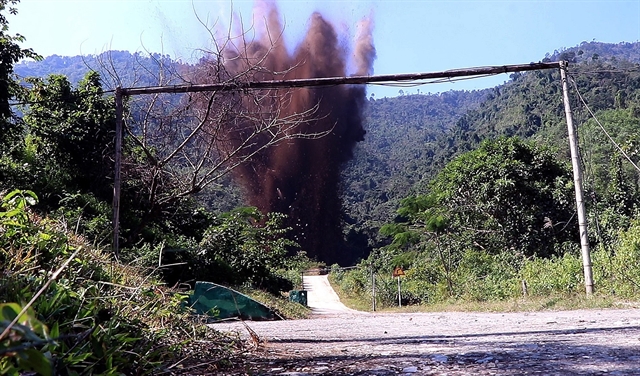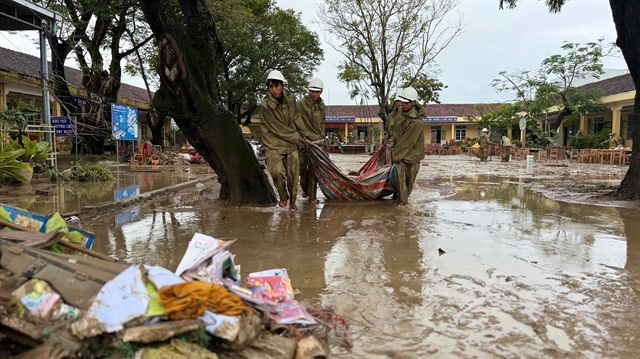 Society
Society

 |
| Rainwater floods into the motorbike parking basement at an apartment block in Hà Nội. — VNA/VNS Photo |
HÀ NỘI — When historic rains recently swept through Hà Nội, they did more than drench the streets – they flooded the city from below. Dozens of apartment buildings saw their underground parking areas turn into murky pools. Cars and motorbikes were submerged, electrical systems threatened, and many residents found themselves trapped and powerless in their own homes. For urban dwellers, it was a stark reminder that rapid development has made basements some of the city’s most vulnerable infrastructure points.
The weak link beneath the city
At an apartment complex along Lê Trọng Tấn Street, resident Huy Hoàng said the area turns into a 'water basin' whenever it rains heavily.
"Not only did the connecting roads get flooded, but the parking basement also became a swimming pool. Families are always anxious during the rainy season," he said.
Architect Phạm Anh Quân described apartment basements as 'the timid systems' of urban buildings – fragile yet essential. Because they sit below ground level, they are the first to be invaded when the city’s drainage system becomes overwhelmed.
"Basement parking areas and technical rooms are the most vulnerable parts in any apartment building when there’s a major downpour or flood," he said.
Low elevation makes them easy targets for stormwater overflow. Once the public drainage network is clogged or overburdened, water naturally finds the easiest path – downwards, into the basements.
Architect Cao Hoàng Anh, Director of ACA Investment and Construction Architecture Co. Ltd., explained that many basements are simply not designed for today’s extreme conditions.
"Designs often fail to anticipate the scale of modern flooding. Entrances are built level with or even below the road surface. There are no water-catching gutters at the entrances, and the general drainage systems don’t align properly with the city’s main infrastructure," he said.
In many urban zones, nearby canals and sewers are blocked with trash, leaves and debris, worsening the problem. Many buildings lack one-way valves, flood barriers or automatic doors that could close off entry points as water rises.
Makeshift defences and rising dangers
Damage from basement flooding can be severe. Vehicles and personal belongings left in waterlogged basements lose value quickly, often requiring costly repairs.
Water seeping into electrical panels, generators and technical rooms can trigger short circuits, creating fire hazards and endangering residents.
"Even a building’s critical infrastructure can fail. Backup pumps, generators, and water-supply systems can all be destroyed when exposed to dirty water," one expert noted.
Once basements are flooded, residents cannot retrieve their vehicles and daily life grinds to a halt.
Many apartment management boards have scrambled to protect residents by mobilising security staff and volunteers to install sandbags and operate pumps. Yet when rainfall is too intense, even these efforts are overwhelmed.
"If the floodwater reaches the substation, the entire building loses power. Elevators stop, lighting cuts out – everything goes dark," said head of the Management Board at VP6 Apartments Hoàng Thế Vinh.
"Once the substation is damaged, you can’t restore electricity immediately. The whole building becomes paralysed."
Experts agree that reactive measures like sandbags and emergency pumping are not enough. To protect residents and property, Hà Nội needs systematic upgrades – both technical and managerial – to build genuine urban resilience.
Designing smarter, maintaining better
Architects recommend raising basement entrances higher than road level and installing drainage gutters in front of every entry to divert water before it can flow inside. Drainage systems should also be properly connected to the city’s main sewer network to prevent water stagnation.
Automatic floodgates and retaining walls can seal off basements when water levels rise, providing an active layer of protection. Inside, high-capacity pumps with water-level sensors can expel floodwater quickly, while mobile backup pumps can serve as an emergency safety net.
Routine maintenance is equally important, especially before the rainy season begins. Regular inspection and test runs of pumps, valves and pipelines can identify problems early and ensure systems remain reliable when needed most.
In recent years, some building managers have started looking to technology for help. Software platforms like Building Care, which include more than 20 modules for technical, financial and resident management, are being introduced in several apartment complexes.
These systems can monitor basement conditions, issue early warnings about rising water levels and automatically activate anti-flood mechanisms when necessary.
Digitising building management, experts say, not only speeds up responses but also increases transparency and efficiency. With data from sensors and automated alerts, staff can intervene before a small leak becomes a disaster.
According to Nguyễn Việt Anh, Vice President of the Vietnam Water Supply and Sewerage Association and lecturer at the Hanoi University of Civil Engineering, sustainable flood prevention requires a comprehensive approach.
He outlines a framework that combines structural solutions – Separation, Absorption, Storage, Drainage and Transfer – with non-structural measures such as Information, Adaptation and Finance.
Anh says modern cities should increase permeable areas with rain gardens and absorbent surfaces, build underground reservoirs and regulating lakes, and upgrade drainage networks.
Equally important is developing early-warning systems, collecting hydrological data and using rainfall–flood simulation models to manage flooding more flexibly.
By merging engineering with digital management, Hà Nội can create what he calls an 'adaptive urban ecosystem' – one that minimises damage while improving residents’ quality of life.
For now, many apartment basements across Hà Nội remain exposed to the same risks that recent storms laid bare. But experts say the solutions are within reach: smarter design, stricter maintenance, and the embrace of modern technology.
If the lessons of this storm are taken seriously – if the city’s builders, managers and residents work together – then the next deluge might no longer spell disaster.
Hà Nội’s challenge is clear: to transform the city’s 'dead zones' into symbols of resilience, where safety and preparedness lie deep beneath its surface. — VNS




